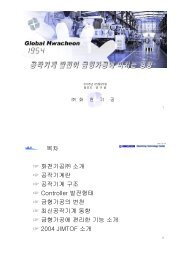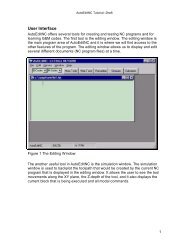Fracture Toughness
Fracture Toughness
Fracture Toughness
You also want an ePaper? Increase the reach of your titles
YUMPU automatically turns print PDFs into web optimized ePapers that Google loves.
<strong>Fracture</strong> <strong>Toughness</strong><br />
is found in thick plates.<br />
Under plane-strain conditions, materials behave essentially elastic until the fracture stress<br />
is reached and then rapid fracture occurs. Since little or no plastic deformation is noted,<br />
this mode fracture is termed brittle fracture.<br />
Plane-Strain <strong>Fracture</strong> <strong>Toughness</strong> Testing<br />
When performing a fracture toughness test, the most<br />
common test specimen configurations are the single edge<br />
notch bend (SENB or three-point bend), and the compact<br />
tension (CT) specimens. From the above discussion, it is<br />
clear that an accurate determination of the plane-strain<br />
fracture toughness requires a specimen whose thickness<br />
exceeds some critical thickness (B). Testing has shown<br />
that plane-strain conditions generally prevail when:<br />
Where: B<br />
is the minimum thickness that produces a condition where<br />
plastic strain energy at the crack tip in minimal<br />
K IC is the fracture toughness of the material<br />
s y is the yield stress of material<br />
페이지 3 / 5<br />
When a material of unknown fracture toughness is tested, a specimen of full material<br />
section thickness is tested or the specimen is sized based on a prediction of the fracture<br />
toughness. If the fracture toughness value resulting from the test does not satisfy the<br />
requirement of the above equation, the test must be repeated using a thicker specimen. In<br />
addition to this thickness calculation, test specifications have several other requirements<br />
that must be met (such as the size of the shear lips) before a test can be said to have<br />
resulted in a K IC value.<br />
When a test fails to meet the thickness and other test requirement that are in place to<br />
insure plane-strain condition, the fracture toughness values produced is given the<br />
designation KC . Sometimes it is not possible to produce a specimen that meets the<br />
thickness requirement. For example when a relatively thin plate product with high<br />
toughness is being tested, it might not be possible to produce a thicker specimen with<br />
plain-strain conditions at the crack tip.<br />
Plane-Stress and Transitional-Stress States<br />
For cases where the plastic energy at the crack tip is not negligible, other fracture<br />
mechanics parameters, such as the J integral or R-curve, can be used to characterize a<br />
material. The toughness data produced by these other tests will be dependant on the<br />
thickness of the product tested and will not be a true material property. However, plane-<br />
http://www.ndt-ed.org/EducationResources/CommunityCollege/Materials/Mechanica...<br />
2012-03-06
















